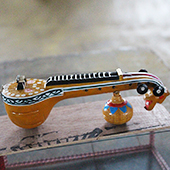Veena Making - Bobbili, Andhra Pradesh
Veena is made out of jackfruit tree wood, which is lightweight and possesses qualities like excellent reverberation, clear grain lines, and great durability. The woods are seasoned by placing in shades. The accurate size of the wooden log is chosen and cut. The Veena has three major parts: resonator, Dandi (neck), and pegbox and design in the front known as Yali. A resonator is a big bowl where the sound is produced. It is hand-carved using a custom-made handheld scraping tool, which is capable of removing large chunks of wood. This process is carried out only by hand and requires great skill, expertise, and experience. The quality of the music largely depends on the proper making of the resonator. The finished resonator appears like a big bowl. The resonator has a top cover used to cover it. This cover is made out of the same wood. A small table like a wooden bridge, topped by a convex-shaped brass plate, is glued in place with resin, and this bridge is fixed on the resonator cover. The Dandi (neck of the Veena) is attached to the resonator; the Dandi (tapering hollow-neck) is a U-shaped lengthy wooden piece of approximately 51inch in length and width is 3 ½ inches, which is hollow inside. The hollow curvature of the Dandi is covered on the top by a board on which the fingerboard is fixed. The fingerboard is fixed on the Dandi using nails. The fingerboard consists of 24-brass frets set in a mixture of scalloped beeswax and charcoal powder and a tuning box culminating in a downward curve and an ornamental dragon or yali head. The distance between the brass frets is fixed by checking for the musical note by plucking the strings. At the end of the curve is the small box with a cover, which holds the plectrums. On the sides of the Dandi are the tuning knobs made out of rosewood used for tightening the strings. There are two sets of tuning knobs five numbers on one side and two on the other. There are seven strings on the Veena, the first two strings are of steel, and the other five strings are made out of brass. One end of the string is tied to the tuning knobs, and the other end of the string is tied to the tailpiece, which is a metal piece in the form of a shield that is screwed onto the main resonator. The four main strings press against the wooden bridge. Apart from the main body, certain brass and bronze parts are crucial for holding the wooden parts of the Veena together, improving the tonal quality and adding to the aesthetic value of the instrument.
There is a lot of decorative inlay carving on the body of the Veena, which has been done on a plastic sheet. Earlier, these inlays were of ivory. The carved inlays are coloured using the lac. The lac is heated and filled in the carving grooves; once it's dried, the inlay is scraped using a blade to remove the excess lac, which leaves only the grooves filled with colours, and the design appears. Depending on the customer's requirement, the Veena is painted or polished. Once it is ready, the Veena is sent for tuning. It takes around 20 days to make one complete Veena.


































